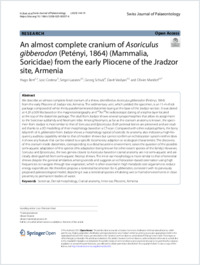An almost complete cranium of Asoriculus gibberodon (Petényi, 1864) (Mammalia, Soricidae) from the early Pliocene of the Jradzor site, Armenia
DOKPE
- Bert, Hugo University Claude Bernard, Lyon
- Costeur, Loïc ORCID Natural History Museum, Basel
- Lazarev, Sergei ORCID University of Fribourg
- Schulz, Georg ORCID University of Basel
- Vasilyan, Davit ORCID University of Fribourg
- Maridet, Olivier ORCID University of Fribourg
- 2025
Published in:
- Swiss Journal of Palaeontology. - Springer Science and Business Media LLC. - 2025, vol. 144, no. 1
English
We describe an almost complete fossil cranium of a shrew, identified as Asoriculus gibberodon (Petényi, 1864) from the early Pliocene of Jradzor site, Armenia. The sedimentary unit, which yielded the specimen, is an 11-m-thick package composed of white thinly-parallel-laminated diatomite laying at the base of the Jradzor section. It was dated at 4.29 ± 0.09 Ma based on the magnetostratigraphy and 40Ar/39Ar radioisotopic dating of a tephra layer located at the top of the diatomite package. The skull from Jradzor shows several synapomorphies that allow its assignment to the Soricinae subfamily and Neomyini tribe. Among Neomyini, as far as the cranium anatomy is known, the specimen from Jradzor is most similar to that of Soriculus and Episoriculus. Both petrosal bones are preserved and are studied thanks to a 3D modelling of their morphology based on a CT-scan. Compared with other eulipotyphlans, the bony labyrinth of A. gibberodon from Jradzor shows a morphology typical of soricids. Its anatomy also indicates a high-frequency auditory capability similar to that of modern shrews but cannot confirm an echolocation system neither does it shows any feature that can be related to a specific locomotory adaption or ecological characteristic. The discovery of this cranium inside diatomites, corresponding to a distal lacustrine environment, raises the question of the possible semi-aquatic adaptation of this species (this adaptation being known for other extant species of the family). However, Soriculus and Episoriculus, the two genera closest to Asoriculus based on cranial anatomy are not semi-aquatic and are clearly distinguished from semi-aquatic Neomys shrews. The inner ear morphology is more similar to that of terrestrial shrews despite the general similarities among soricids and suggests an echolocation-based orientation using high frequencies to navigate through low vegetation, which is often essential in high metabolic rate organisms to reduce energy expenditure. We therefore propose a terrestrial locomotion for A. gibberodon, consistent with its previously proposed paleoecological model, depicting it was a terrestrial species inhabiting wet or humid environments in close proximity to permanent bodies of water.
- Faculty
- Faculté des sciences et de médecine
- Department
- Département des Géosciences
- Language
-
- English
- Classification
- Palaeontology
- License
- CC BY
- Open access status
- gold
- Identifiers
-
- DOI 10.1186/s13358-025-00357-6
- ISSN 1664-2376
- Persistent URL
- https://folia.unifr.ch/unifr/documents/331973
Statistics
Document views: 8
File downloads:
- s13358-025-00357-6.pdf: 13
